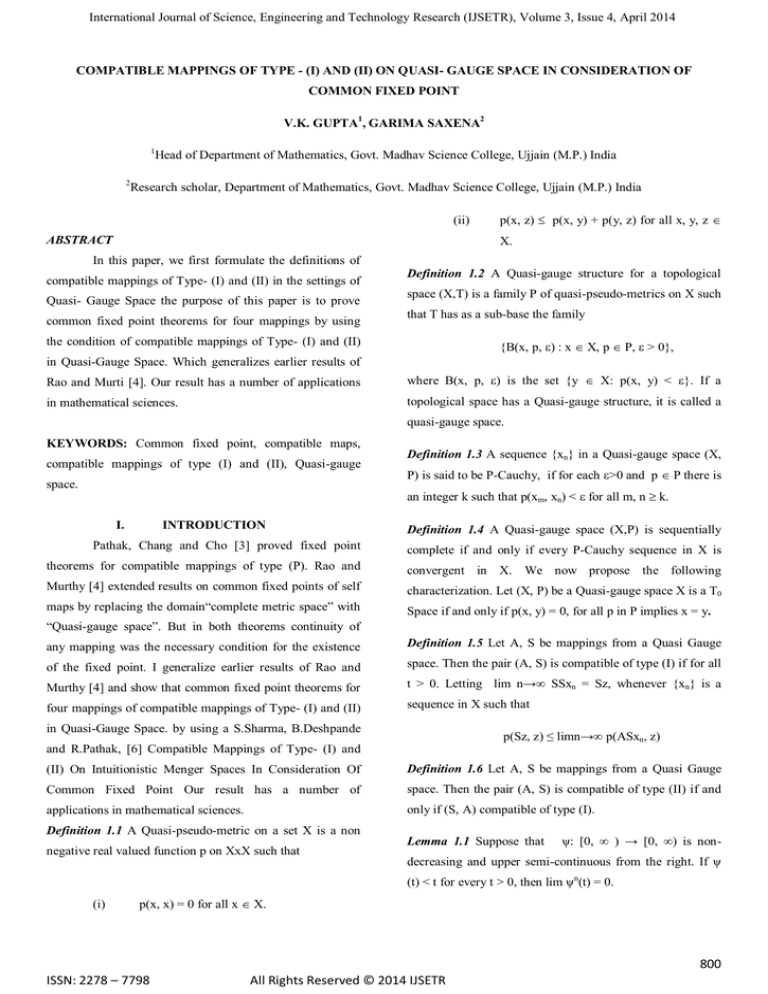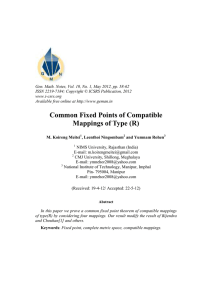
International Journal of Science, Engineering and Technology Research (IJSETR), Volume 3, Issue 4, April 2014
COMPATIBLE MAPPINGS OF TYPE - (I) AND (II) ON QUASI- GAUGE SPACE IN CONSIDERATION OF
COMMON FIXED POINT
V.K. GUPTA1, GARIMA SAXENA2
1
2
Head of Department of Mathematics, Govt. Madhav Science College, Ujjain (M.P.) India
Research scholar, Department of Mathematics, Govt. Madhav Science College, Ujjain (M.P.) India
(ii)
ABSTRACT
p(x, z) p(x, y) + p(y, z) for all x, y, z
X.
In this paper, we first formulate the definitions of
compatible mappings of Type- (I) and (II) in the settings of
Quasi- Gauge Space the purpose of this paper is to prove
common fixed point theorems for four mappings by using
Definition 1.2 A Quasi-gauge structure for a topological
space (X,T) is a family P of quasi-pseudo-metrics on X such
that T has as a sub-base the family
the condition of compatible mappings of Type- (I) and (II)
{B(x, p, ) : x X, p P, > 0},
in Quasi-Gauge Space. Which generalizes earlier results of
Rao and Murti [4]. Our result has a number of applications
where B(x, p, ) is the set {y X: p(x, y) < }. If a
in mathematical sciences.
topological space has a Quasi-gauge structure, it is called a
quasi-gauge space.
KEYWORDS: Common fixed point, compatible maps,
compatible mappings of type (I) and (II), Quasi-gauge
space.
Definition 1.3 A sequence {xn} in a Quasi-gauge space (X,
P) is said to be P-Cauchy, if for each >0 and p P there is
an integer k such that p(xm, xn) < for all m, n k.
I.
INTRODUCTION
Definition 1.4 A Quasi-gauge space (X,P) is sequentially
Pathak, Chang and Cho [3] proved fixed point
complete if and only if every P-Cauchy sequence in X is
theorems for compatible mappings of type (P). Rao and
convergent in X. We now propose the following
Murthy [4] extended results on common fixed points of self
characterization. Let (X, P) be a Quasi-gauge space X is a T0
maps by replacing the domain“complete metric space” with
Space if and only if p(x, y) = 0, for all p in P implies x = y.
“Quasi-gauge space”. But in both theorems continuity of
any mapping was the necessary condition for the existence
Definition 1.5 Let A, S be mappings from a Quasi Gauge
of the fixed point. I generalize earlier results of Rao and
space. Then the pair (A, S) is compatible of type (I) if for all
Murthy [4] and show that common fixed point theorems for
t > 0. Letting lim n→∞ SSxn = Sz, whenever {xn} is a
four mappings of compatible mappings of Type- (I) and (II)
sequence in X such that
in Quasi-Gauge Space. by using a S.Sharma, B.Deshpande
p(Sz, z) ≤ limn→∞ p(ASxn, z)
and R.Pathak, [6] Compatible Mappings of Type- (I) and
(II) On Intuitionistic Menger Spaces In Consideration Of
Definition 1.6 Let A, S be mappings from a Quasi Gauge
Common Fixed Point Our result has a number of
space. Then the pair (A, S) is compatible of type (II) if and
applications in mathematical sciences.
only if (S, A) compatible of type (I).
Definition 1.1 A Quasi-pseudo-metric on a set X is a non
negative real valued function p on XxX such that
Lemma 1.1 Suppose that
ψ: [0, ∞ ) → [0, ∞) is non-
decreasing and upper semi-continuous from the right. If ψ
(t) < t for every t > 0, then lim ψn(t) = 0.
(i)
p(x, x) = 0 for all x X.
800
ISSN: 2278 – 7798
All Rights Reserved © 2014 IJSETR
International Journal of Science, Engineering and Technology Research (IJSETR), Volume 3, Issue 4, April 2014
II.
PRELIMINARIES
(3.1.1) the pairs (A, S) and (B, T) are compatible of type
Rao and Murty [4] proved the following.
(II) and A or B is continuous,
Theorem 2.1 Let A, B, S and T be self maps on a left(right)
(3.1.2) the pairs (A, S) and (B, T) are compatible of type (I)
sequentially complete Quasi-gauge T0 space (X,P) such that
and S or T is continuous,
(i)
(A, S), (B, T) are weakly compatible pairs of
maps with T(X) ⊆ A(X); S(X) ⊆ B(X);
(ii)
A and B are continuous;
(iii)
max{p²(Sx, Ty), p²(Ty, Sx)} ≤ ø{p(Ax,
T(X) ⊆ A(X), S(X) ⊆ B(X) ;
max{p²(Sx, Ty),p²(Ty, Sx)} ≤ ø{p(Ax, Sx)p(By, Ty), p(Ax
,Ty)p(By, Sx),p(Ax, Sx)p(Ax, Ty),p(By, Sx)p(By, Ty),
p(By, Sx)p(Ax ,Sx), p(By, Ty)p(Ax, Ty)};
Sx)p(By, Ty), p(Ax, Ty)p(By ,Sx), p(Ax,
SSx)p(Ax, Ty), p(By, Sx)p(By, Ty), p(By,
for all x, y ∈X and for all p in P, where ø : [0, ∞)⁶ → (0,
Sx)p(Ax, Sx), p(By, Ty) p(Ax, Ty)};
+∞) satisfies the following:
for all x, y X and for all p in P, where ø : [0, ∞)⁶ →
(3.1.3) ø is non-decreasing and upper semi-continuous in
(0, +∞) satisfies the following
each coordinate variable and for each t >0:
(iv)
ø is non-decreasing and upper semi-continuous
Ψ(t) = max{ø(t,0,2t,0,0,2t), ø(t,0,0,2t,2t,0), ø(0,t,0,0,0,0),
in each coordinate variable and for each t > 0
ø(0,0,0,0,0,t) ø(0,0,0,0,t,0)} < t.
Ψ(t)=max{ø(t,0,2t,0,0,2t),ø(t,0,0,2t,2t,0),ø(0,t,0,0,0
then the mappings A, B, S and T have a unique common
fixed point.
,0),ø(0,0,0,0,0,t) ø(0,0,0,0,t,0)} < t;
Proof. Let x0 be an arbitrary point in X. since (3.1.1) holds
Then A, B, S and T have a unique common fixed point.
Theorem 2.2 Let A, B, S and T be self maps on a left(right)
we can choose x1, x2 in X such that Bx1 = Sx0 and Ax2 = Tx1
in general we can choose x2n+1 and x2n+2 in X such that
sequentially complete Quasi-gauge T0 space (X, P) with
(3.1.4) y2n = Bx2n+1 = Sx2n and y2n+1 = Ax2n+2= Tx2n+1; n =
condition (iii) and (iv) of Theorem 2.1 such that
0,1,2.....
(i)
(S, A), (A, S), (B, T) and (T, B) are weakly
We denote dn= p(yn, yn+1) and en = p(yn+1, yn ); now applying
compatible pairs of maps with T(X) ⊆ A(X);
(3.1.2) we get
S(X) ⊆ B(X);
(ii)
One of A, B, S and T is continuous:
max{d22n+2, e22n+2} = max{p²(Sx2n+2, Tx2n+3), p²(Tx2n+3,
Sx2n+2)}
Then the same conclusion of Theorem 2.1 holds.
≤ ø{p(Ax2n+2, Sx2n+2)p(Bx2n+3,Tx2n+3),
We prove Theorem 2.1 and Theorem 2.2 without assuming
p(Ax2n+2,
that any function is continuous and proof a theorem of finite
Sx2n+2)p(Ax2n+2,Tx2n+1),
number of mapping (increasing mappings).
p(Bx2n+3,
III.
Tx2n+3)p(Bx2n+3,
Sx2n+2),
p(Ax2n+1,
p(Bx2n+1,Sx2n+2)p(Bx2n+2,Tx2n+3,),
Sx2n+2) p(Ax2n+2,
Sx2n+1),
p(Bx2n+3, Tx2n+3)
p(Ax2n+2, Tx2n+3)};
Main results
=ø{p(y2n+1 ,y2n+2)p(y2n+2, y2n+3), p(y2n+1,
We prove the following:
y2n+3)p(y2n+2,
y2n+2),
p(y2n+1,
y2n+2,)p(y2n+1,
y2n+3),
Theorem 3.1 Let A, B, S and T be self maps on a left(right)
p(y2n+2, y2n+2)p(y2n+2, y2n+3,), p(y2n+2, y2n+2)p(y2n+1, y2n+2),
sequentially complete Quasi-gauge T₀ Space (X, P) such
p(y2n+2, y2n+3)p(y2n+1, y2n+3)}
that
801
ISSN: 2278 – 7798
All Rights Reserved © 2014 IJSETR
International Journal of Science, Engineering and Technology Research (IJSETR), Volume 3, Issue 4, April 2014
≤ø{ d2n+1, d2n+2,0, d2n+1(d2n+1 + d2n+2),0,0,
d2n+2 ( d2n+1+ d2n+2)}
(3.1.5)
(3.1.6)
(3.1.14)
p(y2m(k), y2n(k)) > ε for 2m(k) >2n(k) >2k
for each positive even integer 2k, let 2m(k) be the least
If d2n+2 > d2n+1 then
positive even integer exceeding 2n(k) and satisfying
max {d²2n+2, e²2n+2} ≤ ø{ d²2n+2, 0, 2d²2n+2, 0, 0,
2d²2n+2} < d²2n+2.
(3.1.13); hence p(y2n(k), y2m(k)-2) ≤ ε
integer 2k,
ε < p(y2n(k), y2m(k)
by (3.1.3) a contradiction; hence d2n+2≤ d2n+1.
(3.1.15)
Similarly we get
≤ p(y2n(k), y2m(k)-2) + (d2m(k)-2 + d2m(k)-1)
From (3.1.12) and (3.1.15), we obtain lim p(y2n(k), y2m(k)) = ε.
(3.1.7) d2n+1≤ d2n.
By the triangle inequality
By (3.1.5) and (3.1.6)
p(y2n(k), y2m(k)) ≤ p(y2n(K), y2m(k)-1) + d2m(k)-1}p(y2n(K),
max{d²2n+2, e²2n+2} ≤ ø{ d²2n+1, 0,
2d²2n+1, 0, 0,
y2m(k)-1) ≤ p(y2n(k), y2m(k)) + e2m(k)-1;
2d²2n+1} ≤ Ψ(d²2n+1)
(3.1.8)
= Ψ{P²(y2n+1,y2n+2)}.
So
(3.1.16) |p(y2n(k), y2m(k))-p(y2n(k), y2m(k)-1)| ≤ max{ d2m(k)-1,
Similarly we have,
e2m(k)-1}.
max{d²2n+1, e²2n+1} ≤ ø { d²2n, 0, 0, 2d²2n, 2d²2n, 0}.
(3.1.9)
then for each even
≤ Ψ {P²(y2n,y2n+1)}.
Similarly By triangle inequality
(3.1.17) |p(y2n(K)+1, y2m(k)-1) - p(y2n(K), y2m(k))| ≤ max{e2n(k) +
So
e2m(k)-1, d2n(k) + d2m(k)-1}
(3.1.10) d²n = P²(yn, yn+1) ≤ Ψ {P²(yn+1, yn)} ≤ . . . ≤
From (3.1.16) and (3.1.17) as k→∞,{p(y2n(K), y2m(k)-1)} and
Ψⁿ⁻¹{P²(y₁, y₂)}
p(y2n(K)+1, y2m(k)-1)} converge to ε. Similarly if p(y2m(K), y2n(k))
> ε,
and
lim p(y2m(K), y2n(k)) = lim p(y2m(K)-1, y2n(k)+1)
(3.1.11)
e²n = P²(yn+1, yn) ≤
Ψ{P²(yn-1, y n)} ≤. . . ≤
= lim p(y2m(K)-1, y2n(k)) = ε as k→∞.
Ψⁿ⁻¹{P²(y 1, y₂)}
Hence by Lemma 1.1 and from (3.1.10) and (3.1.11) we
By (3.1.2)
obtain
ε < p(y2n(K), y2m(k))
(3.1.12)
lim d n = e n= 0.
≤ p(y2n(K), y2n(k)+1) + p(y2n(K)+1, y2m(k))
Now we prove {yn} is a P-Cauchy sequence. To show {yn}
≤ d2n(k) + max{ p(y2n(K)+1, y2m(k)), p(y2n(K), y2n(k)+1)}
is P-Cauchy it is enough if we show {y2n} is P-Cauchy.
Suppose {y2n} is not a P-Cauchy sequence then there is an ε
> 0 such that for each positive integer 2k there exist positive
integers 2m(k) and 2n(k) such that for some p in P,
(3.1.13)
p(y2n(k), y2m(k)) > ε for 2m(k) >2n(k) >2k
= d2n(k)+max{p(Tx2n(k)+1, Sx2m(k)), p(Sx2m(k), Tx2n(k)+1)}
≤d2n(k)+[ø{p(y2m(K)-1, y2m(k))p(y2n(K), y2n(k)+1), p(y2m(K)1,y2n(k)+1)p(y2n(K),y2m(k)),
p(y2n(K),
y2m(k))p(y2n(K),
p(y2m(K)-1, y2m(k))p(y2m(K)-1, y2n(k)+1),
y2n(k)+1),p(y2n(K),
y2m(k)), p(y2n(K), y2n(k)+1)p(y2m(K)-1, y2n(k)+1)}]
y2m(k))p(y2m(K)-1,
1/2
and
802
ISSN: 2278 – 7798
All Rights Reserved © 2014 IJSETR
International Journal of Science, Engineering and Technology Research (IJSETR), Volume 3, Issue 4, April 2014
Since ø is upper semi-continuous, as k→∞ we get that ε ≤
1/2
{ø(0, ε², 0, 0, 0, 0)}
< ε,
which is a contradiction.
Therefore {yn} is P-Cauchy sequence in X. Since X is
Letting lim n→∞
max{p²(z, Tz), p²(Tz, z)}
complete there exists a point z in X such that lim n→∞ yn=z.
≤ø {p(z, z)p(Tz, Tz), p(z, Tz)p(Tz, z), p(z,
z)p(z, Tz), p(Tz, z)p(Tz, Tz), p(Tz, z)p(z, z), p(Tz,
lim n→∞ Ax2n= lim n→∞ Tx2n-1=z
Tz)p(z, Tz)};
and
≤ø (0, p(z, Tz), 0, 0, 0, 0)
lim n→∞ Bx2n+1= lim n→∞ Sx2n-2=z
A contradiction Tz = z.
Now suppose that S is continuous and the pair (A, S) is
compatible of type (I). Hence we have
Letting
Since S(X) ⊆ B(X), there exist a point u∈ X such that Bu =
z = Sz. So by (3.1.1), we have,
lim n→∞ SSx2n = Sz, p(Sz, z) ≤ lim n→∞
p(ASx2n, z)
max{p²(Sz,Tu), p²(Tu,Sz)}
≤ø{p(Az, Sz)p(Bu, Tu), p(Az, Tu)p(Bu,
Setting x = Sx2n, y = x2n+1 in the inequality (3.1.2).
Sz), p(Az,Sz)p(Az,Tu), p(Bu, Sz)p(Bu,
max{p²(SSx2n,Tx2n+1), p²(Tx2n+1,SSx2n}
≤ø{p(ASx2n,
Tu), p(Bu, Sz)p(Az ,Sz), p(Bu, Tu)p(Az,
SSx2n)p(Bx2n+1,
p(ASx2n, Tx2n+1)p(Bx2n+1, SSx2n), p(ASx2n,
SSx2n)p(ASx2n,
Tx2n
Tu)}.
Tx2n+1),
+1),
p(Bx2n+1,
SSx2n)p(Bx2n+1,
Tx2n+1),
p(Bx2n+1,
SSx2n)p(ASx2n,
SSx2n),
p(Bx2n+1,
Tx2n+1)p(ASx2n, Tx2n+1)};
Taking as limn→∞,
max{p²(z, Tu), p²(Tu, z)}
≤ø{p(z, z)p(z, Tu), p(z, Tu)p(z, z), p(z,
z)p(z, Tu), p(z, z)p(z, Tu), p(z, z)p(z, z), p(z, Tu)p(z, Tu )}
Letting lim n→∞,we have
Hence Tu = z since the pair (B, T) is compatible of type (I)
and Tu = Bu = z by Therefore z is a common fixed point of
max{p²(Sz, z), p²(z, Sz)}
the self mappings A, B, S and T.
≤ø{p(Sz, Sz)p(z, z), p(Sz, z)p(z, Sz), p(Sz,
Sz)p(Sz, z), p(z, Sz)p(z, z), p(z, Sz)p(Sz, Sz), p(z, z)p(Sz,
z)};
The uniqueness of the common fixed point of the
mappings A, B, S and T can be easily verified by using the
inequality (3.1.2) In fact, if w∈X be another common fixed
≤ø(0, p(Sz, z)p(z, Sz), 0, 0, 0, 0)
point of A, B, S and T. we have
A contradiction Sz = z.
max{p²(Sz,Tw), p²(Tw,Sz)}
Again replacing x by z and y by Tx2n+1 in the inequality
(3.1.2) we have
Sz)p(Az, Tw), p(Bw, Sz)p(Bw, Tw), p(Bw, Sw)p(Az, Sz),
p(Bw, Tw)p(Az, Tw)};
max{p²(Sz,TTx2n+1), p²(TTx2n+1,Sz)}
≤ø{p(Az,
≤ø{p(Az, Sz)p(Bw, Tw), p(Az, Tw)p(Bw, Sz), p(Az,
Sz)p(BTx2n+1,
TTx2n+1),
p(Az,
Thus z = w.
TTx2n+1)p(BTx2n+1, Sz), p(Az, Sz)p(Az, TTx2n+1),
p(BTx2n+1,
Sz)p(BTx2n+1,
TTx2n+1),
p(BTx2n+1,
Sz)p(Az, Sz), p(BTx2n+1, TTx2n+1)p(Az, TTx2n+1)};
803
ISSN: 2278 – 7798
All Rights Reserved © 2014 IJSETR
International Journal of Science, Engineering and Technology Research (IJSETR), Volume 3, Issue 4, April 2014
[5] Reilly, I.L.., Quasi-gauge spaces. J. Lond. Math. Soc. 6,
1973, 481-487.
References
Journal Papers:
[1] Antony, Jessy and Subrahmanyam, P.V., Quasi-Gauges
and Fixed Points, Univ. u Novom Sadu Zb. Rad. Prirod.Mat. Fak. Ser. Mat. 24 (1), 1994, 31-42.
[2] Matkowski, J.,Fixed point theorems for mappings with
a contractive iterate at a point, Proc. Amer. Math. Soc. 62,
1977, No.2, 344-348.
[3] Pathak, H. K., Chang, S. S. and Cho, Y. J., Fixed point
theorems for compatible mappings of type (P), Indian J.
Math. 36 , 1994, No. 2, 151-166.
[6]. S.Sharma, B.Deshpande and R. Pathak, Compatible
Mappings of Type- (I) and (II) On Intuitionistic Menger
Spaces In Consideration Of Common Fixed Point, IJPAM
Vol.61, No. 2(2010),193-210
Theses:
[7] Antony, J., Studies in fixed points and Quasi-Gauges,
Ph.D. Thesis, I.I.T., Madras(1991).
[4] Rao, I. H. N. and Murty, A. S. R., Common fixed point
of weakly compatible mappings in Quasi-gauge spaces, J.
Indian Acad. Math. 21, 1999, No. 1, 73-87.
804
ISSN: 2278 – 7798
All Rights Reserved © 2014 IJSETR






![(M.P.) Dong-A [11] MAPPINGS](http://s2.studylib.net/store/data/010441581_1-a70e3460008654b4bbba2d64e1b9ccd1-300x300.png)